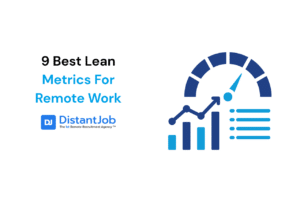Most creative people, including developers, have their own “method” of coming up with new ideas or egging on breakthroughs. They can even be territorial about their ways. That’s why software development and remote work are a match made in heaven. Just ask us.
But creativity and grind are a bad match. For developers working off-site, it can also mean isolation.
You—the leader— need to help your developers remain creative through the long haul so that your team can do their best work.
That’s why, today, we’re exploring ways you can weave creativity into your work fabric and keep your developers from becoming bored.
4 Tips to Promote Creativity Through The Different Stages of the Work Process
Creativity is not homogenous throughout the work process or a product/service’s lifecycle.
Hence, how it should be prompted (not ordered) should also evolve. So, let’s break down “creativity” in the different stages of a business.
1. Ensure creativity when hiring your remote dev team
The people you hire will make a big difference to your team’s creativity quotient.
- Big picture + small picture: Candidates who can bring a balance between the details and the big objectives can focus on software development goals.
- Resilient attitude: Employees who know that not all ideas are winners, but aren’t afraid to come up with new ones, can be creative on demand.
- Inclusive hiring: Build a dev team that encourages pluralism. Like-minded individuals who agree on everything won’t challenge a team’s thinking.
If you cast your hiring net far and wide, as with remote recruitment, you can easily find a diverse team.
2. Build work processes that stimulate creativity
Instead of “asking” your team of developers to be creative, implement practices that allow them to be so.
- Separate implementation from the creative process: Adding barriers at the beginning of ideation can hamper the creative process. First, generate ideas. Then, measure them for practicality.
- Context is everything: Unless developers have a clear idea of who’ll use the product, when, to solve which problems – their thinking will be limited and mechanical.
- Organic thinking: Mulling over ideas as well as impromptu thinking can lead to new ways of doing things. So allow your developers time for both.
- Explore the “discomfort” zone: Let your developers work on a different part of the project. They’ll have a different approach than someone who does it routinely.
- Time to share: If you incorporate “reflection” into your work routine and never share those thoughts with the group, it’ll mean little.
- Try gamification: When stuck in a creative rut, add extreme challenges – like a 90-second ideation contest. Not all ideas will be noteworthy, but it can restart the wheels.
- Creativity techniques: When “organic thinking” fails your team, use a more structured approach – like SCAMPER or mind-mapping.
- Testing, tweaking, and breaking stuff: Sometimes, improvements can be geared towards a concrete goal, like reducing load time. But it can also be a “sport” to see how the product holds up in extreme circumstances, which can unearth unknown weak points.

3. Manage in a way that fosters creativity
A leader’s role in nurturing creativity transcends work processes to re-evaluating how they manage their team of developers.
- Give a compass, not a roadmap: Your remote developers will need a clear idea of what they’re doing. Doesn’t mean they’ll need to be told how. So, make your specs clear and then clear out – don’t micromanage.
- Involve developers in problem-solving: Don’t use developers as mechanics to simply write the code, or you’ll be underutilizing their true potential.
- Transparency is the correct path: Sequestering knowledge is the wrong way to collaborate. You can easily get your team to sign NDAs and then disclose the project in full.
- Give remote devs a voice: Make space for your remote developers to share their approach and solutions. This will reinforce teamwork and a sense of ownership.
- Pair the right people together: It makes sense that the UX designer and the developer should work together. But grouping unlikely people – who either have distinct roles or approaches to work—can also trigger new ideas.
- Provide the tools required to collaborate: Working on individual problems in isolation can deplete creative resources. So provide your team the means to collaborate – whether that’s remote communication tools, design and prototype tools, or the ability to share and meet virtually.
- Remove barriers: Your greatest task as a leader is not to tell your team what to do but to remove the obstacles that prevent them from doing their jobs properly. Sometimes, this could be as simple as reducing workloads. But it could also mean supporting a team member through a personal crisis. That’s why your job is the toughest.
4. Include creativity in the feedback loop
This last step is where you reiterate your stance on creativity. If you’ve encouraged new ways of thinking but penalized your employees for an idea that didn’t perform as expected, you’re sending the wrong message.
- Accepting failures: Consent to failures, assure your team that there might be missteps, but that shouldn’t deter them from trying.
- Opportunity to learn: Software development is ever-evolving. So, make learning an integral part of your work.
- Customer feedback is motivation: Customer feedback should be an essential source of inspiration for your company. If you make it an opportunity to point the finger, your team will only solve the immediate problem and not go beyond that to make the product better overall.
The problem with creativity, and also a reason why it fails to manifest sometimes, is the lack of encouragement. If a creative idea doesn’t work, people instinctively want to revert to a way of doing things they know to work. Creativity needs a license to fail.
So, take away the binds of implementation, encourage abstract thinking, and push your remote developers to the edge of reason. When your developers are free to think and know their ideas are valued, they will go out of their way to make your product better.
Hiring the right mix of people plays a central role in everything that follows. Distantjob can help you hire vetted remote developers for your team.





